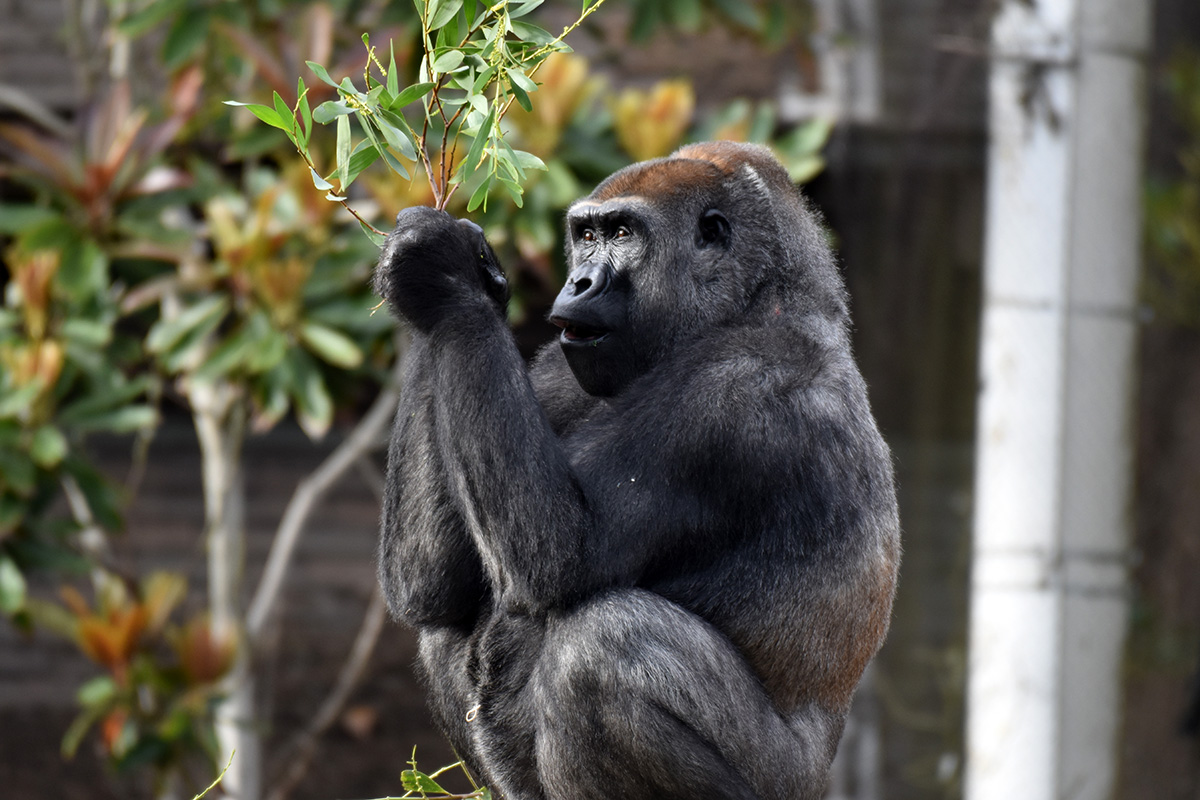Western Lowland Gorilla
Gorilla gorilla gorilla

At the Zoo
You can find the gorillas at the Jones Family Gorilla Preserve, a naturalistic exhibit featuring climbing rocks, tall trees and grass.
Available for Adoption!
An adoption of a western lowland gorilla makes a great gift for friends, coworkers, family or for yourself!
Adopt a western lowland gorilla here.

Fascinating Facts
- The closest relatives of gorillas are chimpanzees and humans, all of whom diverged from a common ancestor about 7 million years ago.
- Gorillas make separate nests for daytime use and night-time use.
- Each gorilla has a unique nose print, just like humans have different fingerprints.
- Dominant males have been known to care for orphaned young within the troop.
Physical Characteristics
Gorillas are the largest of the great apes; they stand up to six feet tall with an arm span of eight feet. They have muscular, stocky bodies and can weigh up to 400 pounds. This species shows a great degree of sexual dimorphism. Mature males, called silverbacks, have a silvery white saddle that appears around 12 – 14 years of age. These males also have a more distinct ridge above the eyes, larger canine teeth, and a large cone-shaped skull.
Lowland gorillas have fine brownish-black fur and often a reddish crown. Gorilla faces are bare, with a short muzzle, large nostrils, and small eyes and ears that lie close to the head. Their hands and feet are broad and strong, and they move about on all fours in a “knuckle-walk.” Gorillas and chimpanzees are the only animals to use the backs of their fingers like feet.
Lifespan is about 35 – 40 years in the wild and up to 54 years in captivity.
Habitat/Diet
The lowland gorilla is found primarily in lowland tropical forests, particularly where there is dense ground-level vegetation, and in swamp forests. They are limited to small areas in Nigeria, Gabon, Equatorial Guinea, the Republic of Congo, Cameroon, and the Central African Republic.
In the wild, gorillas feed on fruit, roots, leaves, grasses, and insects. They play an important role in maintaining the health and diversity of forests by dispersing seeds in their feces. At the Zoo, their diet consists of much of the same food items such as fruit, vegetables, and leaves.
Social Behavior
Despite their great size, gorillas are usually shy and passive animals. They live in family groups, called troops, of 5 to 30 individuals, with an average group size of about 11. Active during the day, gorillas spend most of their time foraging for food. The silverback, the leader of the group, is more of a benevolent dictator, and his authority is rarely challenged. The group may have several younger “blackback” males, and twice as many females as males.
Gorillas sleep in trees, usually a different one each night. The females and youngsters will build comfortable nests of leaves and branches, while the silverback will settle in at the foot of the tree to protect his family.
They use vocalizations, visual signals, and scents to communicate. Compared to other primates, gorillas are generally quiet. They have at least 25 recognized vocalizations, including: grunts, growls, whines, chuckles, hooting, and high pitched barks. The most recognized physical gesture is chest-beating, which is usually the result of a threat or challenge by another male. Dominant males also use a strong odor to communicate with other groups and maintain contact with his own troop.
Females start to breed around 10 years of age, while males do not start to breed before 15-20 years due to competition. Lowland gorillas have a gestation period of about 251 – 295 days, after which they give birth to a single young. Infants cling to their mothers’ belly but move to her back after about four months. They are weaned at 2 1/2 – 3 years but are cared for until about 4 years of age. Lowland gorillas have long intervals between births, usually 4-6 years; when also considering how late in life gorillas reach sexual maturity, it’s easy to see why they have slow population growth.
Status In The Wild
Gorillas are listed as critically endangered by the IUCN and on appendix I of CITES. Over the last 20 – 25 years gorilla numbers have declined by more than 60%. Their small, scattered populations are threatened by increasing human development that causes direct predation and habitat loss. Habitat destruction due to agriculture and logging has opened up forests previously inaccessible to humans. Consequently, gorillas are often hunted for bushmeat, body parts, and illegal pet trade. The Ebola virus is also a major threat and has the potential to eliminate the largest remaining populations of Western lowland gorillas.
The San Francisco Zoo participates in the AZA’s Species Survival Plan for western lowland gorillas. The zoo welcomed the birth of a male gorilla in 2008. The Zoo is also partnered with the Dian Fossey Gorilla Fund to provide scholarships for conservation students working in their communities in Africa. The Dian Fossey Gorilla Fund donation box is located in the Jones Family Gorilla Preserve.
What can you do to help gorillas?
- Don’t support illegal trade by purchasing anything made from gorillas.
- Support conservation efforts of organizations like the Dian Fossey Gorilla Fund, World Wildlife Fund, and AZA-accredited zoos.
- Spread the word about gorilla conservation!
















